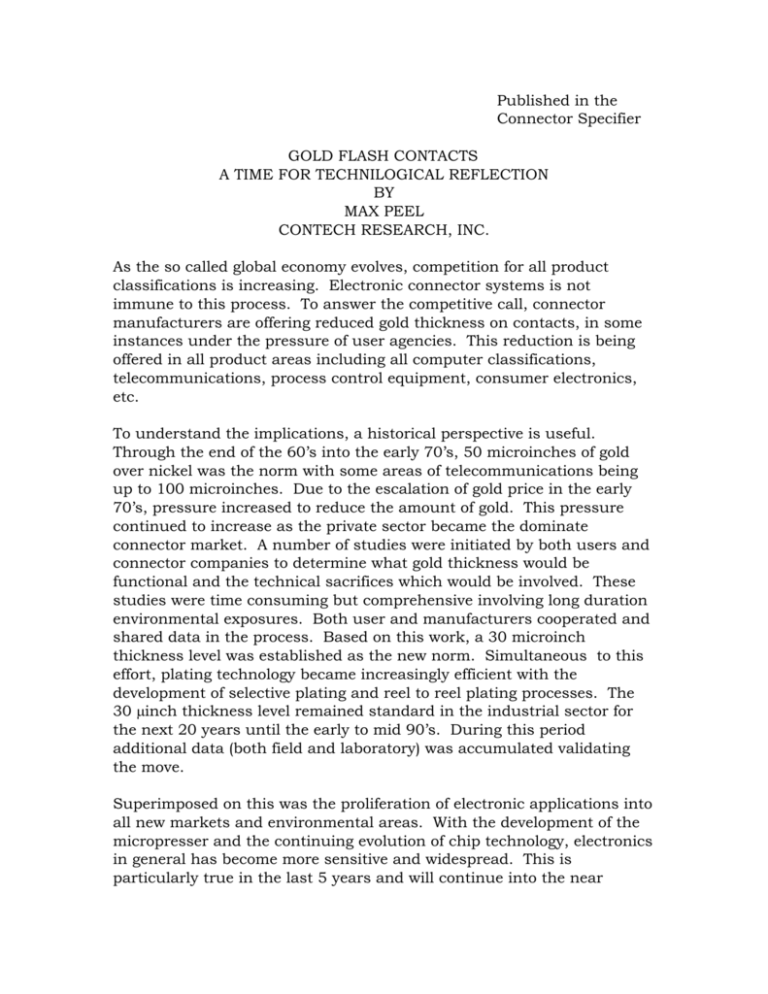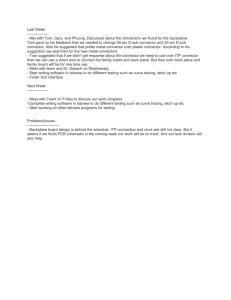gold flash contacts - Contech Research Inc.
advertisement

Published in the Connector Specifier GOLD FLASH CONTACTS A TIME FOR TECHNILOGICAL REFLECTION BY MAX PEEL CONTECH RESEARCH, INC. As the so called global economy evolves, competition for all product classifications is increasing. Electronic connector systems is not immune to this process. To answer the competitive call, connector manufacturers are offering reduced gold thickness on contacts, in some instances under the pressure of user agencies. This reduction is being offered in all product areas including all computer classifications, telecommunications, process control equipment, consumer electronics, etc. To understand the implications, a historical perspective is useful. Through the end of the 60’s into the early 70’s, 50 microinches of gold over nickel was the norm with some areas of telecommunications being up to 100 microinches. Due to the escalation of gold price in the early 70’s, pressure increased to reduce the amount of gold. This pressure continued to increase as the private sector became the dominate connector market. A number of studies were initiated by both users and connector companies to determine what gold thickness would be functional and the technical sacrifices which would be involved. These studies were time consuming but comprehensive involving long duration environmental exposures. Both user and manufacturers cooperated and shared data in the process. Based on this work, a 30 microinch thickness level was established as the new norm. Simultaneous to this effort, plating technology became increasingly efficient with the development of selective plating and reel to reel plating processes. The 30 inch thickness level remained standard in the industrial sector for the next 20 years until the early to mid 90’s. During this period additional data (both field and laboratory) was accumulated validating the move. Superimposed on this was the proliferation of electronic applications into all new markets and environmental areas. With the development of the micropresser and the continuing evolution of chip technology, electronics in general has become more sensitive and widespread. This is particularly true in the last 5 years and will continue into the near future. During this last period of time, a new drive has occurred to reduce gold thickness levels less than 30 microinches to as low as 2 or 3 microinches. This move has not been initiated on the same level as the move to 30 microinches. Basically, the decision has been marketing without technological back up with insufficient and in some cases irresponsible studies. The comment commonly heard from the manufacturers is “the move is to be price competitive and besides, we have had no reported problems”. The definition of gold flash is considered anything < 10 inch (microinch) gold. To understand whether this system is a super saver or a ticking time bomb, one has to revisit the common failure mechanisms that could exist with contact systems such as: a) b) c) d) Corrosion: Edge Creep and Pore Corrosion Fretting Corrosion resulting from thermal and/or vibratory meduims Diffusion, Migration Wet and Dry Oxidation Mechanisms The above are time dependent mechanisms and occur within a few weeks up to years in field applications. The failure trigger is contingent on application and environmental severity’s imposed. This is further complicated by a number of interrelating connector design features such as: a) b) c) d) e) f) g) h) Normal Force Durability Levels required (wear) Contact pin count (is the connector 40 positions or 400 positions) Electrical requirements (power, signal, high speed data, etc.) Connector environmental shielding features Contact geometry, redundancy and configuration Wipe End of life considerations During the past 3 to 5 years, there has been reported an increasing number of problems involving the use of gold flash contacts. This has resulted in a number of evaluations to be initiated. With one or two exceptions these studies are not yet being performed on a comprehensive basis, but addressing specific issues. The following are the results of a sampling of these studies to illustrate the pertinent points of concern. Durability and Humidity Durability is a measure of the number of possible mating cycles which may be typical of the wear occurring on a contact system in its application. Wear may cause one or two problems - expose the underplate/base metal or entrap wear debris between the two contact surfaces. One study, as an example, involved a number of connector configurations as indicated below. The study involved the following: a) No. of Mating Cycles b) Plating Thickness : : c) Connector Types : d) Procedures : 1, 25, 50 30 to 40 in Au/Ni and 5 to 10 in Au/Ni Card Edge “Din” Type D. Submin Type DMG (Dimethylglyoxime) - Spot Test, Thermal Cycling with Humidity The DMG test is simple. After durability cycling, the contacts are dipped into a solution of DMG in accordance with EIA (Electronic Industries Association) 364, Test Procedure 85. If the gold has been worn thru exposing the nickel underplate, it will have a bright red color. The following are the results as observed: Cycled 1X : 10 in Au - Minor Spots 30 in Au - No Spots Cycled 25X : 10 in Au - Sustained wear tracks 30 in Au - No Spots Cycled 50X : 10 in Au - Heavy wear tracks 30 in Au - A few Spots Additional connectors were exposed to a temperature cycle with humidity environment. This involved a 10 day exposure with temperature cycling between 25°C to 65°C at a humidity level of 90-95%. LLCR (low level circuit resistance) was performed using a 100 ma test current and a 20 mv open circuit voltage so as not to disturb any surface films or oxides which had formed. The change in LLCR was monitored. The results are shown in Table 1. TABLE I CHANGE IN LLCR (Milliohms) 10 in 30 in Avg. Max. Durability Level Change Change A) CARD EDGE (100 Positions) 1X -0.2 +2.1 25X +6.6 +113.8 50X +50.7 +612.3 B) DIN TYPE (96 Positions) 1X +0.2 +0.5 25X +2.8 +15.8 50X +4.1 +32.8 C) D-SUBMIN (25 Positions) 1X +0.1 +0.3 25X +0.3 +6.8 50X +3.6 +46.7 Avg. Max. Change Change -0.5 0.0 -0.2 +1.5 +1.0 +1.2 0.0 +0.2 +0.1 +0.5 +0.6 +0.3 0.0 +0.4 +0.1 +1.1 +1.9 +1.8 The connectors used in this study were procured from distribution and involved three different manufacturers, one for each connector family indicated. The above results are obvious comparing the two thickness. Essentially the 10 in gold system remained stable when mated only once and increased degradation occurred as durability increased. The card edge was an “open” (non Shielded) design with the contacts exposed directly to the humid environment. The “Din” and D-Sumbin designs were well shrouded and protected by the design features normally employed. Although the DIN and D-Submin connectors were sheltered, they were also showing signs of degradation when gold flash contacts were used. The normal force of the contact systems for all three connector families was 100-125 grams but a direct comparison between families is difficult due to contact size and configuration differences. Examination of the connectors revealed the following: A) Card edge connector : The chamfer on the mating card was rough with a “sandpaper” texture. This resulted abrasive wear which very quickly penetrated the gold exposing large areas of nickel underplate at both the 25 and 50 mating cycle levels. Exposed nickel in air will oxidize. The addition of humidity accelerates this oxidation although it is self limiting in nature (generally 70 to 80 angstroms). This thin film is very tenacious and resistive in nature. B) DIN and D-Submin Types : The mating portions of these connectors were relatively smooth. The resultant wear was adhesive and thus less damaging. Although nickel was exposed, it was not as significant as with the card edge. Another factor was the connector shrouding or shielding features which offered a form of protection. Although it was approaching unstable levels (after 50 mating cycles), they exhibited a significantly lower magnitude of change (still unacceptable but not catastrophic). Harsh Environment Harsh environments exist in every area of the world to varying degrees. From a practical point of view, there is no such area with a benign environment. For many years, relatively high gas concentrations have been used for evaluation purposes. This has been felt to be unrealistic since no correlation or accelerator factors have been established. The test environment gaining in popularity is the so called Battelle mixed flowing gas procedures which utilizes low concentration of 3 or 4 gases. It is based on field data generated over a number of years. In evaluating connectors, those on backplanes can normally be exposed unmated for a portion of the duration and are generally header types. This is to simulate option card applications. The contact pins in this case are not well protected or shielded from the environment. Additionally 25 cycles of durability was performed prior to the exposure. Table II is a summary compliation of results from various studies performed over a wide variety of connector families relative to unmated exposure duration’s. TABLE II EXPOSURE TIME (UNMATED - DAYS) Gold Thickness 5 in 10 in 15 in 30 in Notes: 2 Days CLII S-M S-M S S 4 Days CLII M-U S-U S-M S 1. SO2 not included 2. Durability included 3. S = Stable (< +15 m, R) M = Marginal (+15 to +50 m, R) 6 Days CLII M-U M-U S-M S 10 Days CLII U U M-U S-M U = Unstable (>+50 m, R) 4. No surface conditioners used Analysis of the Class II exposures indicate that the results were dependent on contact geometry’s, normal force, plating integrity, surface conditions, etc. relative 10 in of gold. The 30 in thickness level appeared to be almost independent of these variables up to and including 6 day exposure levels. Failures involved pore corrosion and edge effects. Similar tests in the mated state only, had similar results except the acceptable % increased. This was attributed to the effectiveness of the connector shielding (shrouding, etc.). Thermal Environment The following table indicates the results of a temperature life study on standard type DIN connectors. The test environment was 500 hours at 85°C. All backplane connectors were header (plug connectors) style and the “daughter” card unit contained right angle receptacle connectors. The results indicate (except for manufacturer 4) that the contact systems remained stable in this environment for both the 10 and 30 in gold product. Porosity testing on manufacturer 4 contacts indicated gross porosity existed on the pin and socket contacts, thus implying heavy influence of the exposed nickel underplate. The plating for manufacturer 4 was considered poor quality. The other manufacturers contacts were also tested for porosity. Although porosity did exist on the 10 in gold product, it was not gross and ranged from 1 to 2 pores per contact within the contact area. The results shown herein is typical with other connector styles tested at 85°C. The systems remained stable as long as gross porosity was not an issue. There are indications, however, that there is potentially increased problems as the temperature increases. Although this is not an aggressive environment, this study illustrated that plating integrity can be a major contributing factor. TABLE III CHANGE IN LOW LEVEL CIRCUIT RESISTANCE 10 IN 30 IN Manufacturer Manufacturer Manufacturer Manufacturer Summary 1 2 3 4 +5.7 +11.9 +10.6 +592.3 m m m m +3.8 +5.8 +4.8 +6.3 m m m m The results as discussed above are similar with other studies which have been performed. In essence, the 30 in gold thickness products appear to have consistent performance regardless of product family or manufacturer (unless plating quality is at issue). The gold flash system appears to be lacking this consistency. As indicated above, the gold flash product performance varies from manufacturer to manufacturer as well as between product families. Putting aside basic limitations (such as durability), those products with gold flash which appear to perform in a satisfactory manner appear to be tied to the following interrelated variable among others: a) b) c) d) e) Plating Quality (process capability) Normal Force Levels Contact Geometry and Configuration Surface Conditions Contact Sheltering Techniques The above indicates that a gold flash product may be successfully used but in a tightly product controlled manner if the performance limitations are known. This implies that this type product may be used in application specific situations after, however, proper technical evaluations have been performed. The common perception of using this plating system in a generic sense without objective performance characterization, is on the other hand a problematic issue. A secondary danger is to allow this system to be used in other connector families after successful use in a specific application. This is also a “ticking time bomb”. This, unfortunately, is todays thinking and philosophy employed by a large segment of industry. Based on todays perceptions and a “sell at all cost” philosophy, a new law has evolved which answers the basic question reflected in the title of this article. Peel’s Law Anyone who uses, buys, sells, manufactures or specifies generic socket/connector product families with gold flash, deserves all of the problems which can result. It is hoped that over time this law will become obsolete. However, without proper data generation to address performance and lot to lot consistency, it will not go away. It is important to remember that cost savings are important in a competitive market but the product still must function properly. Thus as the title of this article implies, it is time for engineering reflection to overcome the emotion of the “sell at any cost philosophy”.






